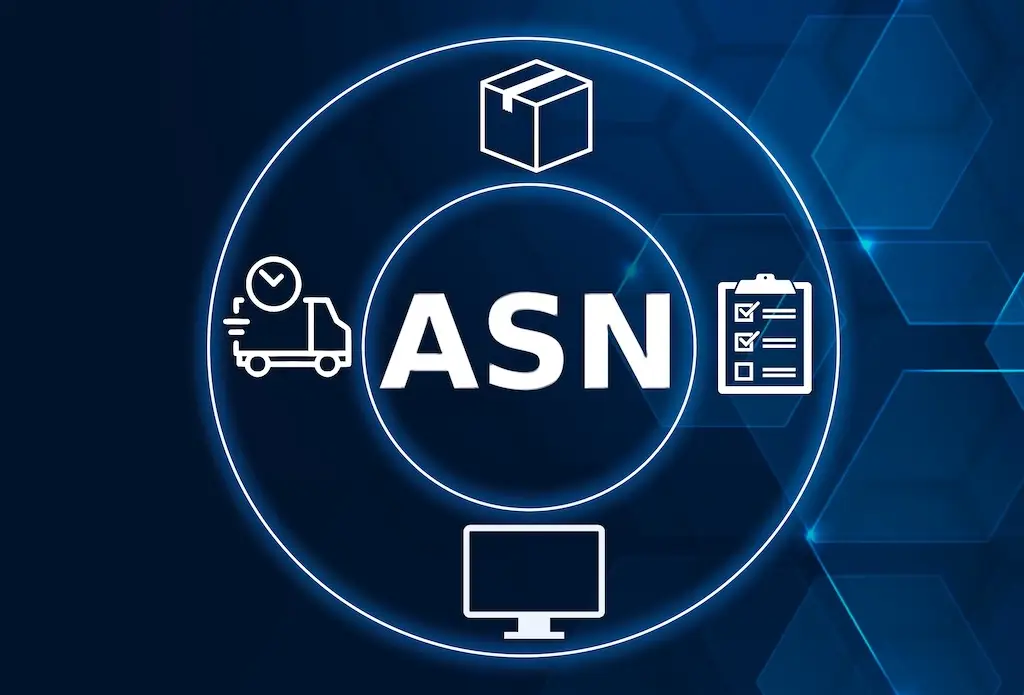An Advance Shipping Notice (ASN) informs customers about the details of an upcoming shipment, enabling better preparation and efficient receiving processes. This notification contains essential shipment information like contents, quantities, and expected delivery dates. In this article, learn what an ASN is, its critical components, and how it boosts supply chain efficiency.
Key Takeaways
- An Advance Shipping Notice (ASN) is a key document that provides essential shipment details to both suppliers and customers, enhancing overall supply chain coordination.
- The integration of Electronic Data Interchange (EDI) facilitates faster and more accurate ASN communication, significantly reducing errors and improving efficiency.
- Implementing ASNs offers numerous benefits, including improved order accuracy, enhanced supply chain visibility, and streamlined receiving processes for all stakeholders involved.
What is an Advance Shipping Notice (ASN)?
An Advance Shipping Notice (ASN) is a crucial notification sent from suppliers to customers that includes detailed information about a shipment. Think of it as a heads-up about what’s coming your way. This notification typically covers shipment contents, quantities, and the expected delivery date. The primary objective of an ASN is to provide all the necessary details about the products being shipped, allowing both parties to prepare adequately.
ASNs are particularly vital for B2B transactions, where the volume and complexity of shipments necessitate meticulous planning and coordination. Issued by the shipper, often the seller or supplier, ASNs are typically sent as soon as the order is ready for shipment, ensuring that all stakeholders are in the loop about the upcoming deliveries.
Key Components of an ASN
At its core, an advanced shipping notice is a comprehensive document that includes several key components. These components are designed to provide a clear and detailed overview of the shipment, ensuring that all parties have the information they need to manage the receiving process effectively.
The key components of an ASN include:
- Item details
- Quantities
- Shipping information
- Billing information
- Expected delivery date
Each shipment is assigned a unique ASN, which helps in tracking and managing the specific shipment through the supply chain, including item tracking details. This detailed information ensures that the receiving party can prepare for the shipment accurately, thereby reducing the risk of misunderstandings or errors.
The Role of Electronic Data Interchange (EDI) in ASNs
The role of Electronic Data Interchange in the context of ASNs cannot be overstated. EDI plays a pivotal role in facilitating the automated exchange of ASNs between trading partners, thereby eliminating manual processes and reducing errors associated with traditional communication methods. EDI allows businesses to exchange ASNs electronically, resulting in faster communication, improved security, reduced costs, and seamless integration with back-office systems.
The automation provided by EDI means that businesses can enjoy a more streamlined and error-free process. This electronic exchange of information enhances operational efficiency and ensures that all parties involved in the supply chain are on the same page.
The seamless integration of EDI with existing systems further ensures that the data flow remains uninterrupted, allowing for better coordination and management of shipments.
Understanding EDI
Electronic Data Interchange, or EDI, is essentially a digital method for exchanging documents and information between trading partners. The primary purpose of EDI is to share information digitally, thereby eliminating the need for paper-based communication. This digital transformation not only speeds up the process but also significantly reduces the chances of errors that are commonly associated with manual data entry.
There are many benefits to using EDI. By eliminating mistakes and breakdowns in communication, EDI proves to be a highly cost-effective way of sending documents. However, for businesses to successfully integrate EDI, they must ensure that their systems are compatible and that data formats are standardized across all trading partners.
EDI 856: The Standard for ASNs
Among the various EDI standards, EDI 856 is particularly important for ASNs. This standard was developed to improve communication and transparency in shipping processes, especially amid growing global trade and complex supply chains. The EDI 856 form, which must follow the x12 format established by the American National Standards Institute (ANSI), is essential for notifying the receiving party about incoming shipments.
Often mandated by major retailers, the EDI 856 standard ensures that all necessary information about a shipment is communicated accurately and efficiently. By using this technology, businesses can ensure that their ASNs are precise and timely, thereby enhancing overall supply chain efficiency.
Benefits of Using Advanced Shipping Notices
The implementation of Advanced Shipping Notices brings a multitude of benefits to businesses. ASNs improve efficiency and communication between suppliers and customers, which in turn enhances overall logistics efficiency. Utilizing ASNs significantly improves communication and coordination, leading to more streamlined supply chain operations.
ASNs also play a critical role in improving accuracy, enhancing efficiency, increasing visibility, strengthening business relationships, and improving forecasting. These benefits, when combined, ensure that businesses can manage their supply chains more effectively, ensuring timely deliveries and fostering stronger partnerships.
Enhanced Supply Chain Visibility
ASNs are invaluable for enhancing visibility within the supply chain. They offer a comprehensive overview of incoming shipments, enabling better planning and resource allocation. This visibility allows companies to manage their logistics more efficiently, ensuring that they are always prepared for upcoming deliveries.
The real-time updates provided by ASNs allow businesses to proactively manage their deliveries, which is crucial for maintaining smooth operations. With detailed information about shipment status, companies can arrange resources and labor based on the anticipated deliveries, preventing stockouts and overstock situations. This level of visibility not only improves supplier efficiency but also aids in better inventory management.
For suppliers, the enhanced visibility provided by ASNs translates into real-time updates on order status, which helps in inventory management. This detailed information allows suppliers to improve their shipping processes and maintain optimal inventory levels, further enhancing overall supply chain efficiency.
Improved Order Accuracy
One of the most significant advantages of using ASNs is the improvement in order accuracy. The use of EDI to exchange ASNs cuts down on manual processes, thereby reducing the likelihood of human error. This electronic data exchange ensures that the right products and quantities are received, which is crucial for accurate order fulfillment.
ASNs are closely associated with packing lists to ensure that the physical contents match the reported details, thus minimizing discrepancies. Clear and precise shipment details in ASNs help maintain high data accuracy, reduce operational disruptions, and enhance customer satisfaction.
Streamlined Receiving Process
Advanced Shipping Notices significantly streamline the receiving process. When customers receive timely notifications about shipments, they can prepare their warehouse space and resources more effectively. This preparation leads to faster unloading and inventory processing, reducing overall receiving costs.
The communication facilitated by ASNs enhances overall supply chain efficiency by ensuring that all parties, including suppliers, customers, and carriers, are on the same page. The use of EDI further streamlines this process, enhancing the speed and accuracy of information exchange between partners.
For customers, the receipt of an ASN serves as a document that informs them about the specifics of an upcoming shipment, allowing them to organize their warehouse operations more effectively. This streamlined process not only improves efficiency but also leads to significant cost savings.
How ASNs Impact Different Stakeholders
Advanced Shipping Notices have a profound impact on various stakeholders within the supply chain. For suppliers, ASNs help manage shipping and communication more effectively, enabling them to optimize their operations and reduce errors. Customers, on the other hand, benefit from improved order tracking and reduced receiving costs, enhancing their overall purchasing experience. Carriers utilize ASNs to optimize delivery schedules and routing, ensuring timely and efficient shipment processes.
Understanding the specific benefits for each stakeholder is crucial for appreciating the comprehensive impact of ASNs. The following subsections will delve deeper into how ASNs affect suppliers, customers, and carriers, providing a detailed look at the advantages for each group.
Suppliers
For suppliers, ASNs offer a range of benefits that can significantly enhance their operations. A typical ASN includes vital information such as item descriptions, quantities, carrier information, and the anticipated delivery schedule. This detailed information allows suppliers to prepare for incoming goods more effectively, reducing the likelihood of errors and improving the accuracy of deliveries.
The use of ASNs leads to significant cost reductions by optimizing warehousing and transportation operations. They streamline shipment processing for suppliers, improving the speed and efficiency of the receiving process and ensuring efficient handling of incoming inventory in warehouses.
Effective implementation of ASNs requires careful planning and coordination with trading partners to ensure that the information is communicated and processed correctly.
Customers
Customers stand to gain immensely from the use of ASNs. One of the primary benefits is improved order tracking, which allows customers to anticipate delivery schedules and prepare their facilities accordingly. This preparation can lead to faster unloading and inventory processing, reducing the costs associated with receiving shipments.
Retailers, in particular, benefit from ASNs as they enable them to allocate resources effectively ahead of incoming shipments. The enhanced tracking and efficiency provided by ASNs result in lower operational costs, making the overall purchasing experience more streamlined and cost-effective for customers.
Carriers
Carriers also benefit significantly from the use of ASNs. By leveraging ASNs, carriers can enhance shipment efficiency, which has a substantial impact on their delivery operations. ASNs provide carriers with detailed shipment information, including routing information and scheduling data, allowing them to optimize their delivery routes and schedules.
This optimization not only improves logistics but also reduces operational costs by ensuring that deliveries are timely and efficient. ASNs improve routing and scheduling, allowing carriers to enhance logistics operations and ensure timely, efficient deliveries while also enabling better control routing.
Implementing ASNs in Your Business
Implementing ASNs in your business requires careful planning and communication with trading partners. The process involves several steps, including selecting the right technology and integrating it with existing systems. Proper planning ensures that the implementation process is smooth and that the benefits of ASNs are fully realized.
One of the key considerations in implementing ASNs is the upfront investment in technology, such as RFID and barcode scanning equipment. While this can be a barrier for smaller businesses, the long-term benefits of enhanced efficiency and accuracy make it a worthwhile investment.
Choosing the Right EDI System
Choosing the right EDI system is crucial for the successful implementation of ASNs. An effective EDI system should support the specific needs of ASN transactions, including compliance with standards like EDI 856. Standardizing data formats and ensuring system compatibility between partners helps avoid workflow interruptions.
Successful ASN integration requires a system that is flexible enough to adapt to various software and hardware components, allowing for seamless communication. Implementing EDI can lead to increased operational efficiency by automating data exchanges among trading partners, making it a critical component of any ASN strategy.
Integrating ASNs with Existing Systems
Integrating ASNs with existing autonomous systems can be complex, particularly if those systems are not designed to accommodate ASN data formats. However, this integration is essential for automating inventory tracking and receiving processes, which can significantly enhance operational efficiency.
Training staff to proficiently use the ASN system is also critical. Their understanding directly impacts the system’s effectiveness, making it important to invest in comprehensive training programs. By ensuring that all stakeholders are well-versed in using the ASN system, businesses can maximize the benefits of their investment.
Common Challenges with ASNs and How to Overcome Them
Implementing ASNs is not without its challenges. Common issues include discrepancies in item quantities and data entry errors, which can lead to shipment delays and reduced efficiency. To minimize these discrepancies, businesses should employ rigorous data validation and frequent audits of ASN data entries.
Another significant challenge is the complexity of integrating ASNs with various systems and processes across different stakeholders. To address these integration challenges, businesses should prioritize selecting compatible EDI systems and establishing clear communication channels with partners.
Understanding how ASNs impact various stakeholders is crucial for overcoming these hurdles and ensuring a successful implementation.
Data Accuracy Issues
Data inaccuracies in ASNs often arise from mismatches in item quantities and errors in line or header information. These inaccuracies necessitate resending corrected data packets, causing potential disruptions in the shipping process. Regular audits and validations of data are necessary to maintain accuracy.
By implementing robust data validation processes and frequently auditing ASN data entries, businesses can significantly reduce the risk of inaccuracies. These measures ensure that the information communicated via ASNs is precise, thereby minimizing operational disruptions and improving overall supply chain efficiency.
Integration Difficulties
Integrating ASNs can be challenging as it involves aligning various systems and processes across different stakeholders. Successful integration requires a deep understanding of how ASNs impact suppliers, customers, and carriers, ensuring that all parties are on the same page.
Focusing on efficient integration of ASN processes with current systems helps overcome these challenges. This not only enhances operational efficiency but also strengthens relationships among trading partners by ensuring that communication and data exchange are seamless.
Comparatio’s EDI Solutions for Advanced Shipping Notices (ASN)
At Comparatio, we specialize in seamless EDI integration to help businesses automate and optimize their Advance Shipping Notice processes. Our EDI 856 solutions ensure accurate, real-time communication between suppliers, customers, and carriers—eliminating errors and delays that can disrupt your supply chain.
Why Choose Comparatio?
- Automated ASN Processing – Reduce manual data entry and errors with fully automated ASN generation and transmission.
- Seamless ERP Integration – Our solutions integrate effortlessly with SAP, NetSuite, QuickBooks, Microsoft Dynamics, and more.
- Retail Compliance – Meet ASN requirements for major retailers like Walmart, Target, Amazon, and Home Depot without hassle.
- Real-Time Visibility – Improve supply chain transparency with instant updates on shipments, inventory, and order status.
- Scalable & Customizable – Whether you’re a small supplier or a global enterprise, we tailor EDI solutions to fit your needs.
By leveraging Comparatio’s ASN EDI solutions, your business can experience faster receiving processes, improved inventory accuracy, and better supplier-customer relationships. Let us help you streamline your shipping and logistics operations today.
Summary
In conclusion, Advance Shipping Notices are a powerful tool that can significantly enhance supply chain operations. By providing detailed information about shipments, ASNs improve supply chain visibility, order accuracy, and streamline the receiving process. The integration of ASNs with Electronic Data Interchange further enhances their effectiveness by reducing manual processes and errors.
Implementing ASNs in your business requires careful planning, selecting the right EDI system, and ensuring seamless integration with existing systems. Despite the challenges, the benefits of ASNs—ranging from improved efficiency to stronger relationships with trading partners—make them a valuable addition to any supply chain strategy. Embracing ASNs can lead to more efficient operations, timely deliveries, and ultimately, a more robust bottom line.
Optimize Your ASN Process with Comparatio
Ensure accurate, efficient, and automated ASN transactions with Comparatio’s EDI solutions. Reduce errors, improve supply chain visibility, and stay compliant with major retailers.
Get started today – Contact us to learn more.
Frequently Asked Questions
What is an Advance Shipping Notice (ASN)?
An Advance Shipping Notice (ASN) is basically a heads-up from suppliers to customers about what’s in a shipment and when it will arrive. This way, everyone can get ready and ensure a smooth delivery process.
How does Electronic Data Interchange (EDI) facilitate ASNs?
EDI streamlines the exchange of Advanced Shipment Notices by automating communication between trading partners, which cuts down on manual errors and speeds up the process. This means smoother operations and less hassle for everyone involved.
What are the key components of an ASN?
The key components of an ASN are item details, quantities, shipping and billing information, and the expected delivery date, all tied together by a unique ASN for tracking. This helps keep everything organized and on track for your shipments.
What are the benefits of using ASNs in supply chain management?
Using ASNs in supply chain management boosts visibility and order accuracy, making the receiving process smoother. Plus, they foster better communication between suppliers and customers, ultimately leading to more efficient logistics.
What challenges might a business face when implementing ASNs?
Implementing ASNs can lead to challenges like data accuracy and integration with existing systems. To tackle these, focus on rigorous data validation and choose compatible EDI solutions.





